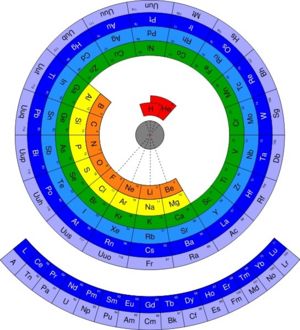Periodic Table Of The Elements
 From Conservapedia
From Conservapedia 
The periodic table of the elements is a diagrammatic tool to illustrate the scientific theory of periodicity in chemistry, in which the elements have similar properties based on their position on the table. For example, the elements on the far left of the table (Group one) all demonstrate similar properties, such as softness and high reactivity. The table has a lot of predictive power, although there are many exceptions to the periodic properties.
The modern periodic table was first developed by Russian chemist Dimitri Mendeleev. Its layout accurately arranges elements by their electron configuration, atomic number, and chemical properties. Using the structure he created, Mendeleev predicted the existence and properties of several yet-undiscovered elements; when those elements were discovered, his estimates proved to be quite accurate, vindicating his theory which had previously been criticized. Other chemists, such as Antione Lavoisier, and Johann Wolfgang Döbereiner had attempted to create periodic tables by grouping similar elements, but Mendeleev was successful because he left empty spaces for undiscovered, but predicted elements.
Organization[edit]
Elements in the periodic table are ordered by number of protons, and rows are arranged by number of electrons in their outermost electron shell. Since farther out shells have more orbitals, this means that there will be more elements in the lower rows of the periodic table than in the higher rows. For example, for principal quantum number n=1, there is only one s-orbital available, which will fit only two electrons (due to the Pauli exclusion principle, which states that no two electrons can have the same quantum numbers). Therefore, only two elements can be in the top row of the periodic table. As the principal quantum number increases, the number of electrons per shell rises, so the farther-down rows hold more elements.
The group number tells how many electrons an element has in its outermost electron shell. For example, every element in group 8A, the noble gases, has its outermost electron shell completely full.
External links[edit]
- Interactive Periodic Table You've seen it before, but what do all those symbols and numbers really mean? You're about to find out.
- Name the elements in the Periodic Table!
The Periodic Table[edit]
| 1A | 8A | ||||||||||||||||||
|---|---|---|---|---|---|---|---|---|---|---|---|---|---|---|---|---|---|---|---|
1
H 1.008 |
2A | 3A | 4A | 5A | 6A | 7A | 2
He 4.003 | ||||||||||||
3
Li 6.939 |
4
Be 9.0122 |
5
B 10.811 |
6
C 12.011 |
7
N 14.007 |
8
O 15.999 |
9
F 18.998 |
10
Ne 10.183 | ||||||||||||
11
Na 22.99 |
12
Mg 24.312 |
3B | 4B | 5B | 6B | 7B | <--- | 8B | --> | 1B | 2B | 13
Al 26.982 |
14
Si 28.086 |
15
P 30.974 |
16
S 32.064 |
17
Cl 35.453 |
18
Ar 39.948 | ||
19
K 39.102 |
20
Ca 40.08 |
21
Sc 44.956 |
22
Ti 47.9 |
23
V 50.942 |
24
Cr 51.996 |
25
Mn 54.938 |
26
Fe 55.847 |
27
Co 58.933 |
28
Ni 58.71 |
29
Cu 63.546 |
30
Zn 65.37 |
31
Ga 69.72 |
32
Ge 72.59 |
33
As 74.922 |
34
Se 78.96 |
35
Br 79.904 |
36
Kr 83.8 | ||
37
Rb 85.47 |
38
Sr 87.62 |
39
Y 88.905 |
40
Zr 91.22 |
41
Nb 92.906 |
42
Mo 95.94 |
43
Tc [97] |
44
Ru 101.07 |
45
Rh 102.91 |
46
Pd 106.4 |
47
Ag 107.87 |
48
Cd 112.4 |
49
In 114.82 |
50
Sn 118.69 |
51
Sb 121.75 |
52
Te 127.6 |
53
I 126.9 |
54
Xe 131.3 | ||
55
Cs 132.91 |
56
Ba 137.34 |
57*
La 138.91 |
72
Hf 178.49 |
73
Ta 180.95 |
74
W 183.85 |
75
Re 186.2 |
76
Os 190.2 |
77
Ir 192.2 |
78
Pt 195.09 |
79
Au 196.97 |
80
Hg 200.59 |
81
Tl 204.37 |
82
Pb 207.19 |
83
Bi 208.98 |
84
Po 210 |
85
At 210 |
86
Rn 222 | ||
87
Fr 215 |
88
Ra 226.03 |
89**
Ac 227.03 |
104
Rf [261] |
105
Db [262] |
106
Sg [266] |
107
Bh [264] |
108
Hs [265] |
109
Mt [268] |
110
Dt [271] |
111
Rg [272] |
112
Cn [277] |
113
Nh [284] |
114
Fl [289] |
115
Mc [288] |
116
Lv [292] |
117
Ts [294] |
118
Og [294] |
||
| *Lanthanides | 58
Ce 140.12 |
59
Pr 140.91 |
60
Nd 144.24 |
61
Pm 145 |
62
Sm 150.35 |
63
Eu 151.96 |
64
Gd 157.25 |
65
Tb 158.92 |
66
Dy 162.5 |
67
Ho 164.93 |
68
Er 167.26 |
69
Tm 168.93 |
70
Yb 173.04 |
71
Lu 174.97 |
|||||
| **Actinides | 90
Th 232.04 |
91
Pa 231 |
92
U 238.03 |
93
Np 237.05 |
94
Pu 239.05 |
95
Am 241.06 |
96
Cm 244.06 |
97
Bk 249.08 |
98
Cf 252.08 |
99
Es 252.08 |
100
Fm 257.1 |
101
Md 258.1 |
102
No 259.1 |
103
Lr 262.11 |
|||||
Categories: [Chemistry] [Elements]
↧ Download as ZWI file | Last modified: 02/23/2023 08:02:25 | 39 views
☰ Source: https://www.conservapedia.com/Periodic_table_of_the_elements | License: CC BY-SA 3.0
 ZWI signed:
ZWI signed: KSF
KSF